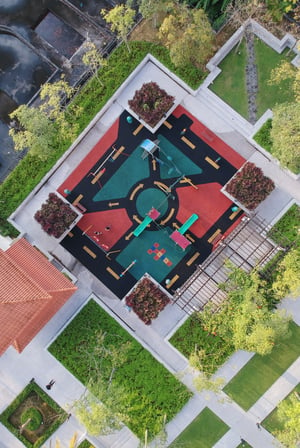 Play has always been an innate part of the childhood experience. Long before there were playgrounds of any kind, children were creating their own using little more than their imaginations. Play is important for the cultivation of motor skills as well as physical strength and stamina. Children also learn social skills from playing together in groups. Country children had it best in this respect — a crooked stick became a lightning-fast steed, while a small stream became a vast and mysterious ocean. Play occurs in all cultures and is an essential part of healthy childhood development, even though playgrounds themselves are a relatively recent addition. The first public playground was built in San Francisco in the year 1887, and playgrounds as we know them gradually came into existence as cities grew larger and outdoor play in the streets and in vacant lots became increasingly dangerous. However, it took over a century for the idea of inclusive playgrounds to even begin to make a dent in America's cultural landscape.
Play has always been an innate part of the childhood experience. Long before there were playgrounds of any kind, children were creating their own using little more than their imaginations. Play is important for the cultivation of motor skills as well as physical strength and stamina. Children also learn social skills from playing together in groups. Country children had it best in this respect — a crooked stick became a lightning-fast steed, while a small stream became a vast and mysterious ocean. Play occurs in all cultures and is an essential part of healthy childhood development, even though playgrounds themselves are a relatively recent addition. The first public playground was built in San Francisco in the year 1887, and playgrounds as we know them gradually came into existence as cities grew larger and outdoor play in the streets and in vacant lots became increasingly dangerous. However, it took over a century for the idea of inclusive playgrounds to even begin to make a dent in America's cultural landscape.
How It Started
A 1991 study brought awareness to the lack of inclusive playgrounds in public places when it suggested that disabled children were experiencing "play deprivation," which has been found to seriously impact healthy childhood development. The Architectural and Transportation Barriers Compliance Board developed accessibility guidelines in the year 2000 that were enacted into federal law one decade later, giving play areas until March 15, 2011, to be in compliance. The ruling was specific to new construction and alterations of existing playgrounds.
However, substantial differences exist between Americans with Disabilities Act (ADA)-accessible play areas and inclusive playgrounds. ADA requirements involve accessibility for children with physical disabilities, while inclusive playgrounds also take the specific needs of children with sensory processing disorders such as autism into consideration in their design plans. ADA-compliant facts include wheelchair ramps with double rails that provide superior grip, barrier-free travel routes, low-impact surfaces, and a variety of accessible play options such as wheelchair-height sandboxes and customized swings. Inclusive playgrounds feature sensory-rich options such as activity panels that provide children with the opportunity to express themselves in a variety of ways, including music, touch, and mental exploration. They also include areas where children who are prone to sensory overload can get some downtime, such as talking tubes and other safe spaces.
The Future of America's Playgrounds
Playgrounds all across the country will continue to make great strides in becoming both ADA-compliant as well as inclusive, and there will be an increased emphasis on innovative play equipment designed with input from child-development experts and physical therapists. Examples include custom-designed themed playgrounds that are built with the purpose of unleashing little imaginations. Traditional playground designs will expand to the mainstream to meet the needs of disabled children.
There are currently more than 2,500 inclusive playgrounds available to the general public in the U.S., and more are being built every day. The city of Chicago alone has over 400 of them. Please feel free to contact us at your convenience for more information on inclusive play.



